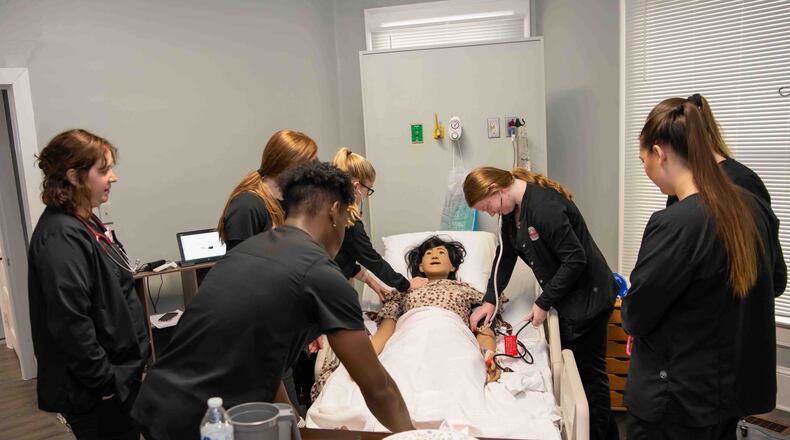In the simulation house, students get active learning by practicing skills, learning how to properly use equipment and taking part in simulations related to community health, critical care, mother and baby, pediatrics, and psychiatric nursing, said Stacy Gilson, nursing resource center and simulation laboratory coordinator.
Gibson said realism is the primary goal of the of the nursing skills lab and the simulation house.
“We want our students to experience as much as possible in a safe, learning environment prior to graduating and becoming licensed nurses. The students remember lessons learned in this low-stakes, safe environment, and are able to carry that with them when they move on to higher-stakes patient care,” Gilson said.
The program acquired the simulation house during the COVID-19 pandemic, which allowed instructors space to maintain social distancing while teaching in-person.
The house was maintained with original lighting and electric, but it was updated on the first floor to accommodate the program’s electronic devices for simulation, including mannequins, cardiac monitors, tablets and computers. Earlier this year, the electric throughout the house was upgraded as well as the floors and walls.
The renovated simulation house belongs to the university and was formerly used as a temporary housing accommodation for employees. However, with the growth of the nursing program to 110 students, it became harder to schedule time for all student in the current simulation lab.
Students in all levels take nursing classes, including a didactic, lab and clinical component, so many days multiple groups are scheduled to learn different skills, concepts or participate in simulation. Nursing students do not have scheduled times at the simulation house until their junior or senior year, but they are introduced to it at the end of their sophomore year.
“Part of the code of ethics for simulation is confidentiality – mainly so students can feel comfortable making mistakes, and we can maintain a safe learning environment for them, and secondly, so that the younger students can experience a simulation with fresh eyes just as their upperclassman counterparts are able to do,” Gilson said. “Having the sim house allows us to schedule multiple groups on the same day without violating that confidentiality agreement. It also allows us the physical space needed to accommodate so many students.”
The first floor of the house includes a kitchen area used as a staged area for simulations; a conference room for pre-brief and de-brief; a living room where observers are during a simulation; and a large patient care room used for critical care, mother and baby, or psychiatric simulations. The upper level includes a second conference area; a neonatal intensive care unite (NICU) patient care room with a baby mannequin, patient crib and other devices; and a pediatric care room with a six-year-old mannequin.
About the Author

